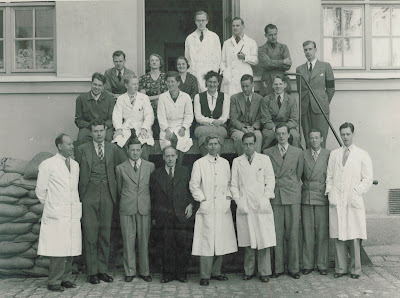PHOTO: Elmer O. Kraemer (1898-1943), front row, third from left, and Wallace Hume Carothers (1896-1937), front row to right of Kraemer, pose circa the 1930's next to the DuPont advanced chemistry research teams they led that invented polyester and nylon. Photo was scanned from one of the original photos taken annually of the DuPont Experimental Station employees that were kept by Thomas Kraemer's grandfather Elmer O. Kraemer and father Herbert F. Kraemer in their family photo albums. After DuPont refocused researchers' efforts away from basic research and instead directed their efforts toward ramping up the production of polyester and nylon to make a profit, Kraemer left DuPont in 1938 and Carothers famously committed suicide in 1937 perhaps aggravated by DuPont's decision to deemphasize his academic research that is more commonly done only by universities instead of by commercial businesses trying to make a profit.
I've written before about the issues surrounding corporate research and the related history book by David A. Hounshell and John Kenly Smith, "Science and Corporate Strategy: Du Pont R and D, 1902-1980," Cambridge University Press, Oct 28, 1988 that included references to the research work on polyester and nylon done by my grandfather Elmer O. Kraemer (1898-1943). (See previous post Corporate research strategy book chronicles my grandfather's work at DuPont (5/11/15))
I was finally able to read one of the key sources cited in Hounshell's book that mentioned my Grandfather Elmer O. Kraemer, specifically, I read the transcript of a 1986 interview of "James Burton Nichols, Oral History," Chemical Heritage Foundation, 1986, chemheritage.org accessed May 8, 2015 and purchased via: Order Transcript Number 0034 of "James Burton Nichols" oral history from chemheritage.org.
James Burton Nichols worked his entire career at DuPont, starting in 1927 as a research chemist working with my Grandfather Kraemer in the 1930's, and until Nichols retired from DuPont in 1966 and before he was interviewed in 1987 by the Chemical Heritage Foundation. Nichols, while working on his M.S. and Ph.D. degrees in Chemistry from the University of Wisconsin, first met my Grandfather Elmer Kraemer who at that time was a faculty member there in the Chemistry Department.
Here are some of my initial notes from reading the 1986 interview with "James Burton Nichols," chemheritage.org accessed May 8, 2015, available for purchase via: James Burton Nichols" oral history conducted 1986 by Chemical Heritage Foundation chemheritage.org:
- (p.80 Index of the printed and bound copy of the 1986 interview with James Burton Nichols) Kraemer is listed as being mentioned on p. 0., 26, 47, 52, 73, and 77 -- polyester p. 47 note 13 p. 77
- (p. 47, 77) Elmer Kraemer is credited by Nichols with inventing polyester, drawing the first strands, and then publishing a scientific paper on it by 1933, well before Carothers was credited with inventing nylon, which was based on the collective work of DuPont researchers.
- (p. 59-60, 65, 68) Nichols discusses how DuPont management, from the 1920's to when nylon was invented in the 1930's, allowed researchers to do what they wanted with little direction from management, but after the Depression had stressed the company financially, management changed its focus to getting products out the door and making money, which resulted in the reassignment of many employees.
- (p. 73, 77) documents the biography of Elmer O. Kraemer that was written by James Burton Nichols after my Grandfather Kraemer died working on a book on colloidal chemistry that he had initiated before his death
- (p. 9-15, 17) Both Nichols and my Grandfather Kramer worked with the Swedish Professor The Svedberg (1884-1971) who won the Nobel Prize in Chemistry 1926 and who lived the swinger lifestyle of having multiple wives -- Grandmother Kraemer recalled the sexually open Swedish lifestyle she experienced while living in Sweden with my Grandfather who was doing both teaching and research in chemistry with Svedberg in Sweden and Germany, which were epicenters of chemistry knowledge at the time.
- (p.73-74) Nichols mentions the annual photographs taken by DuPont of the workers of the DuPont Experimental Station in Wilmington, Delaware where my Grandfather Kraemer worked on advance chemistry research.
The PDF copy I have is a scanned image of a typewritten page, without any optical character recognition text, which makes it impossible for me to easily cut and paste quotes from it. I hope to get some of these quotes included above after I can get some help from a sighted person to type them into a word processor.
See Elmer O. Kraemer (1898-1943) From Wikipedia and "Wallace Hume Carothers (1896-1937)," chemheritage.org accessed Aug. 11, 1015 or Wallace Carothers (From Wikipedia, the free encyclopedia) about arothers clinical depression and suicide in 1937, perhaps caused by his new marriage and the stress of management asking him to redirect his efforts toward making money and helping ramp up production of nylon and other synthetic polymers.
See previous posts Corporate research strategy book chronicles my grandfather's work at DuPont (5/11/15), Elmer Kraemer, chemist, nylon, synthetic rubber pioneer (10/18/09) and Hermann Staudinger on Kraemer 12/16/09) , plus the Elmer Kraemer (Wikipedia) article.)
